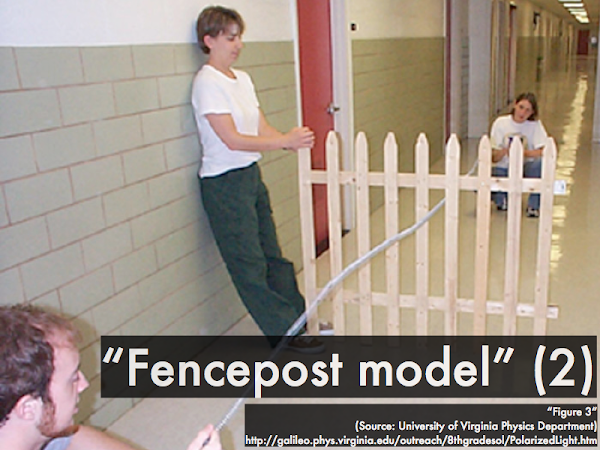Cuesta College, San Luis Obispo, CA
Students have a weekly online reading assignment (hosted by SurveyMonkey.com), where they answer questions based on reading their textbook, material covered in previous lectures, opinion questions, and/or asking (anonymous) questions or making (anonymous) comments. Full credit is given for completing the online reading assignment before next week's lecture, regardless if whether their answers are correct/incorrect. Selected results/questions/comments are addressed by the instructor at the start of the following lecture.
The following questions were asked on re-reading textbook chapters and reviewing presentations on polarization.

Selected/edited responses are given below.
Describe what you understand from the assigned textbook reading or presentation preview. Your description (2-3 sentences) should specifically demonstrate your level of understanding.
"Vertical antennae transmit vertically polarized radio waves, while horizontal antennae transmit horizontally polarized radio waves."
"A transmission axis of a polarizer only allows polarized light to pass through it if the light wave is correctly aligned with it. The 'fenceposts' are like barriers, which reduce the amount of light that is able to come through an object (such as sunglasses). If the transmission is diagonal to the incoming polarization, some light may pass through with less intensity than if it were completely aligned with the axis."
Describe what you found confusing from the assigned textbook reading or presentation preview. Your description (2-3 sentences) should specifically identify the concept(s) that you do not understand.
"How to figure out if light is polarized north-south, east-west, up-down, or unpolarized when the person is looking at scattered in different places in the sky."
"The mathematical problems that accompany the 'fencepost model'--I'm having a hard time conceptualizing how to use the equations given. Can you please also go over polarizer filters and the examples from the presentation."
"I'm still confused about the antennae and radio waves."

0%. ******** [8] 50%. ********************************* [32] 100%. * [1] (Unsure/guessing/lost/help!) **** [4]
Unpolarized light shines through two ideal polarizing sheets, that have their transmission axes aligned at right angles to each other. How much of the original intensity is transmitted through these two sheets?
0%. ********************* [21] 50%. ************ [12] 100%. ***** [5] (Unsure/guessing/lost/help!) ******* [7]

When the light that passed through the first polarizer is now completely blocked by the second polarizer, the transmission axis of the second polarizer is:
horizontal. ****** [6] vertical. ****************************** [30] diagonal, upper left to lower right. **** [4] diagonal, lower left to upper right. * [1] (Unsure/guessing/lost/help!) **** [4]

Light from the screen of the iPad (in portrait mode) is:
horizontally polarized. ************************* [25] vertically polarized. ************* [13] diagonally (upper left to lower right) polarized. ** [2] diagonally (lower left to upper right) polarized. [0] unpolarized. [0] (Unsure/guessing/lost/help!) ***** [5]

Light from the screen of the Nexus 4 is:
horizontally polarized. *********** [11] vertically polarized. **** [4] diagonally (upper left to lower right) polarized. ******* [6] diagonally (lower left to upper right) polarized. *************** [15] unpolarized. ** [2] (Unsure/guessing/lost/help!) ******* [7]
Ask the instructor an anonymous question, or make a comment. Selected questions/comments may be discussed in class.
"Can't wait for class." (Wow--me, too.)
"Can you please go through the presentation questions in class as well as some of the homework problems? I need practice using Malus' law." (Yes, there is always some time to go through the material that most of the class is having the most issues with.)
"No country line dancing club this semester? :(" (We're still finalizing open practice session times/rooms on Friday. Trust me, as soon as that gets settled, you'll hear it from me.)
"How are you?" (Great, if my new hearing aid works out--IT CERTAINLY SEEMS LOUD ENOUGH, BUT I ONLY HAVE ONE DAY TO TRY IT OUT.)
No comments:
Post a Comment